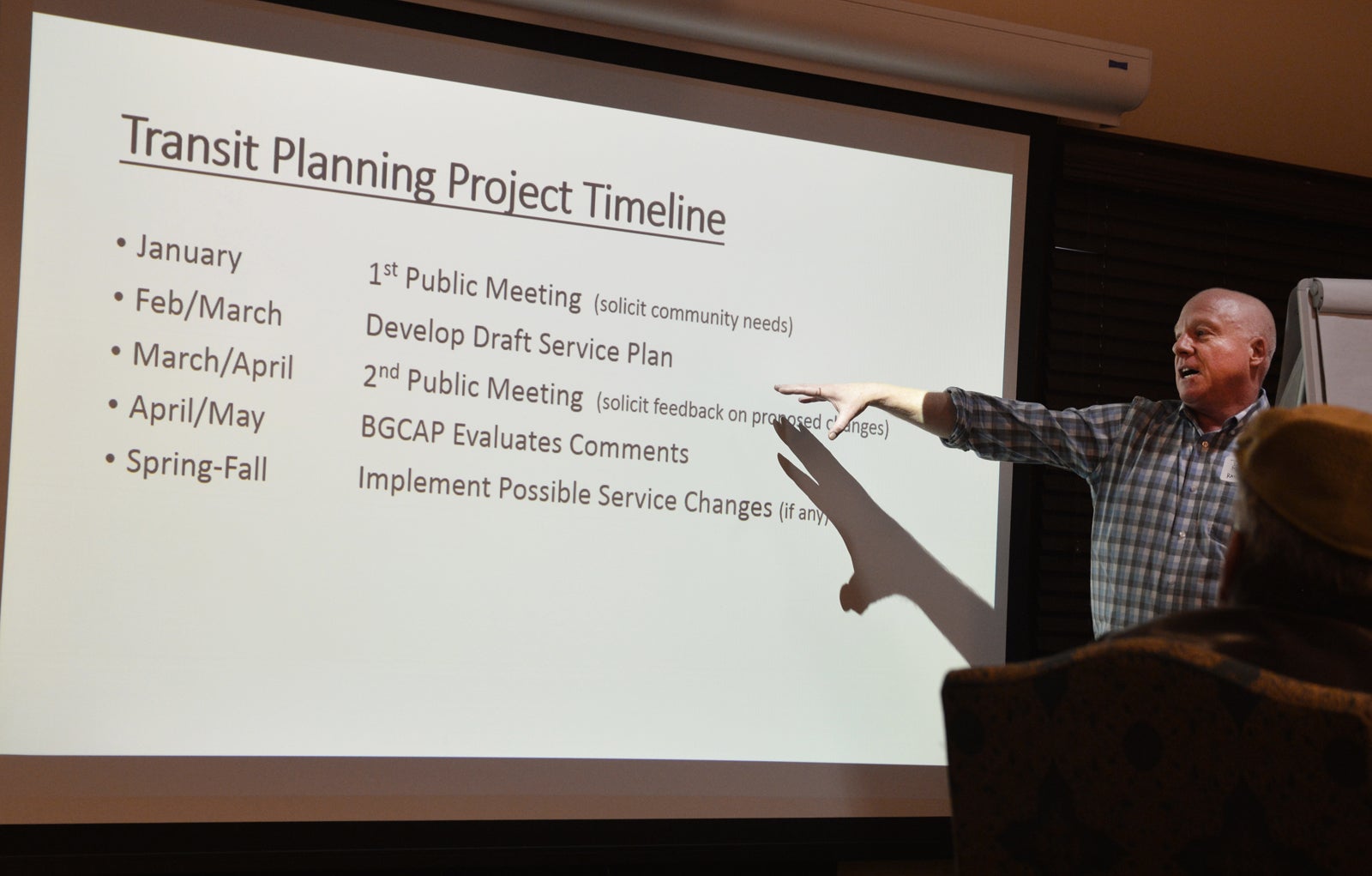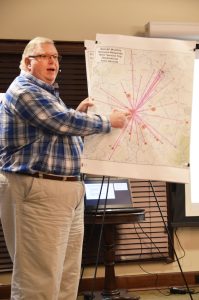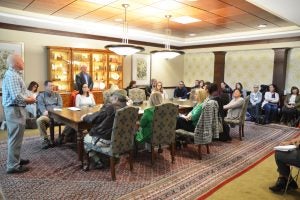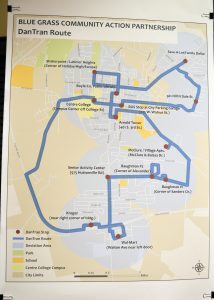Public provides ideas for improving DanTran bus system during forum
Published 6:31 pm Friday, January 31, 2020

- David Minten, transportation planner with RAE Consultants Inc., explains the timeline through Bluegrass Community Action Partnership where community feedback is concerned.
Although the DanTran bus system has been around for 12 years, many in the community aren’t aware of exactly what it does — where and when it goes and for whom. That was the general consensus during the community meeting held Jan. 24 by Bluegrass Community Action Partnership (BGCAP), the organization that runs the transit system.
David Minten, a transportation planner with RAE Consultants Inc. facilitated the meeting, held at the Boyle County Public Library, which resulted in a full room of interested folks. BGCAP’s transit division hired the firm to help them look at their service for efficiencies and possible improvements, he said.
“Also, we have to be here, because (BGCAP) applies to the FDA for grant assistance” in order to be able to provide part of the service, “so it’s required,” he said.
Another public meeting is planned for a follow-up around March or April.
DanTran is a sponsored program of BGCAP and Bluegrass Ultra-Transit Service, and is mostly focused on disabled, lower-income, elderly and veterans in an 11-county area. The system, as a whole, makes 240,000 trips per year, Minten said, “so they’re quite well used.”
Taylor Veatch, BGCAP’s senior director for transportation, said 85% of what the system does is Medicaid-funded.
BGCAP’s executive director, Troy Roberts, said they also provide coordinated, public “demand-response” trips, which means anyone can ride the system with the Medicaid riders. These trips are open to anyone, but need to be scheduled 72 hours in advance and cost $1.75 per mile with a $5 minimum, unless they use a prepaid bus pass, which brings the cost down to $1 a mile, still with the $5 minimum.
“These trips can be to anywhere,” Roberts said.
Many who aren’t approved for Medicaid use the bus to get to work, the store or appointments, for example.
Another offering is the “deviated fixed route” service, which is also open to anyone.
“Because we are classified as a rural area, the bus can deviate from a route by half a mile to pick someone up that may not be able to get to a stop,” Roberts said.
The pickups must be scheduled 24 hours in advance, and there is a limit on the number of deviations the bus can perform to keep it on time. The cost is $2 per person per trip, or $1 with a prepaid bus pass.
All of the information on routes and fares can be found at dantranroute.org. To request a deviation, riders must call (800) 456-6588.
Reaching out to understand

Taylor Veatch, senior director of transportation for Bluegrass Community Action Partnership, discusses the current offerings of the Dan Tran system. The graph, he said, shows about 2,200 trips end in Danville, more than likely showing the regional medical draw of people needing rides to the hospital or doctors’ offices.
Veatch told the group gathered at the library the transit division has been awarded an extra vehicle, which was “one reason why we’re here, trying to find out from the public exactly what you all want.”
“We’re trying to serve you the best we can,” he said. “There’s always that thing about funding — we can’t be everything to everybody. But we’ve got to find out where the needs are.”
Veatch said he was happy so many people were in attendance to give feedback — it was the most they’ve seen in any community so far.
Due to grant funds, the organization is federally required to “periodically touch base with the community” and coordinate with area human service providers, many of which were represented in the meeting. Minten said DanTran wants its transit service to be well-used, and “wants to meet the needs of the community,” so it is looking for possible adjustments that could go into effect later this year.
Veatch said one of the best-kept secrets in town is that “we can take you to Lexington to the airport for $10,” which he said Centre College uses quite a bit. “You don’t have to pay for parking, you get dropped off at the door, and we’ll come back and pick you up at the door when you return.”
Roberts said within the next few weeks, a new door-to-door airport service will be rolling out, with more details to come.
Veatch said there are about 2,200 trips that end in Danville per year.
“I grew up in Danville, so it’s kind of like when Walmart first came here; people from seven counties would come to Danville to shop.”
He said people from other counties still travel to Danville today, but now they are often coming to the area for medical services.
What the community wants/needs
Minten went around the room and gave each person a turn who had questions or ideas for improved services. City Engineer John Cassel said with the current changes to Danville-Boyle County Parks & Recreation, there has been “a lot of emphasis on parks use.” He wondered about the possibility of adding an additional route on the northwestern corner of town, to get out to Millennium Park and maybe the schools in that area.
Cassel also pointed out a gap in the system’s service area through the center of downtown, “straight down to Hustonville Road, to where Fourth and Second streets come together. I’m seeing a lot of people walking up and down through there…”
Bill Pianovski, who does workforce development for the Kentucky Career Center, said the No. 1 barrier to employment he sees is transportation. “I would like to see some type of program to partner up with the industrial park where all the manufacturing facilities are and have set stops around town that brings them out” to that area. He said right on Corporate Drive, there are five factories alone, so one stop would suffice, and that those companies are in constant need of employees.
Several others, including Josh Gooch with the Danville-Boyle County Economic Development Partnership and Goodwill Industries Career Coach Erica Sluder, echoed Pianovski’s sentiment about how intensely transportation barriers affect employment opportunities.
The director of the housing authority, Tim Kitts, said he would like to see some type of transit accessibility to Junction City and Perryville, because the authority has two developments there. Neither of the locations are on the regular route, but could be used by the demand-response service, Minten said. Those rides would be based on availability of vehicles and operators, “so there’s a bit of a discretion on when they can pick you up.”
Kitts also said there’s a restriction on DanTran of one bag per customer, which is hard for those going to the grocery, for instance, because they can’t afford to pay for multiple trips.
Alethea Price, county extension agent for family and consumer sciences, echoed this need, adding, “And we all know, Danville is a food desert,” referring to the lack of grocery stores downtown.
Her concern was also with availability of evening transportation, due to teaching life skills courses, such as parenting classes. People often cannot take advantage of the free courses because they can’t make it out to the extension office on Corporate Drive next to Bluegrass Community Technical College, she said.
Family Services Association Director Crystal McPherson delivered information gathered from a focus group hosted by the United Way, which brought people in poverty together to discuss what barriers they were facing. “Transportation was one of the main focuses,” she said.
The group said they don’t understand the bus system, including when it will be at certain places or its accessibility.
“They also said we need covered areas where they can stand and wait” for the buses, McPherson said.
Suggestions were made the city could help pay for them, offering advertising on the benches, which could pay for themselves in about a year. She said signs are also needed on the buses themselves, indicating what the routes were.

All seats were taken during the transportation meeting held by consultants hired by Bluegrass Community Action Partnership Thursday in the basement meeting room of the Boyle County Public Library. Attendance varied from human service agency representatives and other local organizations, to citizens who are concerned about the transportation offerings in Danville.
Resident Joanna King said she didn’t understand why Danville couldn’t have a regular bus system, as in other cities the same size with the same population, with a set bus route that doesn’t require scheduling the rides in advance.
After the meeting, McPherson said she feels like the general public still doesn’t quite understand what DanTran’s main focus is.
“They could be the agency that does the public transport … here, they heard that there’s a need for it,” she said. “But I felt like people don’t realize they’re not like a Lextran bus (in Lexington) …” because they focus on a certain population.
Aside from human services organizations, Centre College was also well-represented. Anita Bertram said she already works with DanTran doing shuttles back and forth to the airport for students, which has worked out well.
Jessica Leonard works with international students at the college. She said there is Centre transportation that goes from campus to Walmart and Kroger every Saturday, and she also arranges periodic trips to Lexington around the holidays to the international food market. She said students have also expressed interest in an evening bus to go to the Danville cinemas. The bus trips Centre offers on two different buses are free of charge to students.
“It’s paid for out of my office’s budget, but with budget cuts, that might change. There have been problems because of the huge demand, with only two buses going; it’s first-come, first-serve. So it’s been an issue,” Leonard said.
Jesse Weisner works with community service programs at Centre, and is looking for more transportation opportunities to run a scholarship program. She said it currently is made up of 60 students who go out into the community to do 10 hours of volunteer service weekly. Because many of them don’t have transportation, they are forced to only look at agencies within walking distance, “but we have a lot of other different organizations they would like to serve at. We’re trying to find ways to get them there.”
City Commissioner Denise Terry, who was the only elected official at the meeting, said she would like to see some bus stops that riders could use without scheduling ahead, and later in the meeting she agreed the City of Danville could probably look at helping with the bus stops.
“I have lived in survival mode, and you can’t always think that far ahead,” she said.
Some things to consider
Minten said generally, one bus stop every quarter of a mile is a good distance for a fixed bus stop. “But these days, it has to be ADA approved, so if we add a new bus stop, then it’s got to have ramps and meaningful sidewalk access,” which he said “can really add up the cost; a huge expense. It could be the one thing that prevents the service from changing sooner than you might want.”
He said all those improvements “can easily be $10,000; $20,000 if there are drainage problems. … We have to take big breaths here, going to have to take baby steps to see how we can get to it.”
Roberts responded to one citizen’s complaint about a larger bus that was at one time being used that has been taken away and replaced with a smaller van. “We have been working with the state to get some of the vehicles changed out,” he said, which is still in the works.
Others brought up early childhood day care issues, or special arts-related programs offered which many can’t get a ride to.
Roberts said, “Any time you guys have a need in this community for transportation, if you’ll pick up the phone and call one of us, we’re happy to sit down with anyone and try to work out a plan.”

As demonstrated by a graph BGCAP had on hand, many spoke about the gap in bus services through the middle of downtown Danville, especially through the Fourth Street sector.
He said one thing the community needs to realize is that, “DanTran, currently today, is one bus. It makes a loop. We operate in an 11-county area, with our demand-response and Medicaid service … Our buses all look the same except for the number on the back. Guys, this community is a hub. Folks from Casey, Lincoln, Garrard — where do you think they come to the doctor? Here. That’s the reason why a lot of times, in this community, you guys will see buses empty or with one person on them.”
He said that’s because DanTran has brought someone to Danville, dropped them off and are waiting for them to “get done so we can get them back home. A lot of folks don’t realize that; they just think our buses are running but nobody’s on them. There’s a reason for that. It’d be really interesting to figure out what economic impact of the people we’re bringing to this community makes. We’re doing anywhere from 1,000 to 1,200 trips a month.”
Afterwards, Roberts said the well-attended meeting did provide “some really good feedback about DanTran. Although it cannot be everything to everyone, I think many of the requests can be met so that we can make the service better.”






